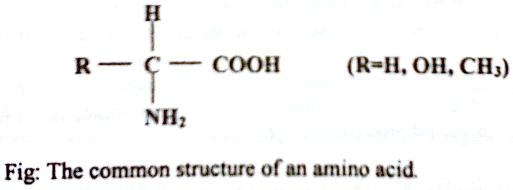Amino acids are the main structural units of protein. Amino acids are formed by the replacement of hydrogens with one to many amino groups (-NH2) in any organic acids. Thus an amino acid contains at least one amino acid group (-NH2) and one carboxylic acid group (-COOH).
Chemical structure: The molecular formula of amino acid is RCH-NH2-COOH.
Thus, on the basis of the variation of ‘R’ amino acids may be of different types. For a simple amino acid glycine, ‘R’ is simply a hydrogen atom.

Classification of amino acid: There are twenty different types of amino acids in plant and animal bodies. These twenty different type’s amino acids are classified into following divisions.
(1) A combination of one amino group and one carboxylic acid group.
- Glycine ii. Alanine iii. Valine iv. Leucine v. lsoleucine
(2) A combination of one amino group and two carboxylic acid groups.
- Glutamic acid ii. Aspertic acid
(3) A combination of two amino groups and two carboxyl groups
- Arginine ii. Lysine iii. Hydroxylycine
(4) Associted with hydroxyl group.
- Threonine ii. Serino.
(5) Associated with sulphur
- Cytine ii. Methionine
(6) Aromatic:
- Phenylalamine ii. Tyrosine
(7) Heterocyclic:
- Tryptophan ii. Proline iii. Hydroxy proline
Functions of protein: The main function of amino acid is to synthesise protein.











